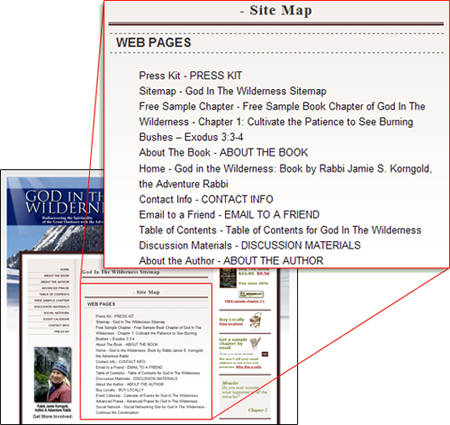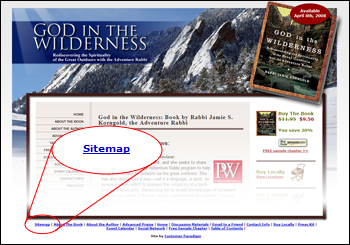eLearning Series
5. Why Sitemaps are Baby Food
For Search Engines Just a few years ago, the philosophy about sitemaps went something like this: If your customers need to use a sitemap to find their way around your website, you haven’t done your job organizing your content and creating a navigational system that is easy to understand.
But sitemaps are now back in favor. Why? It’s less about human visitors and more about search engines. What is a sitemap? A sitemap is page that lists all of the other pages on your site, usually in bulleted list. Here’s an example of a sitemap:
Click the graphic above to see a live sample of a sitemap page. As I’ve discussed before, search engines are easily confused. Many pages of a website are often ‘hidden’ behind tricky menus or drop-down lists. Or, the links to reach a specific page are too deep (i.e. more than a couple of pages down from the home page). A sitemap, linked from the home page of the site, will list every page of your site in one convenient place. When a search engine visits your site map, it’s very easy for them to then get a list of every page on your site, and then crawl, digest and include all of your content in their system. We generally recommend having the link to your sitemap on the bottom footer navigation of your site.
Click the graphic above to see a live sample sitemap link. But you need to make sure that as your site changes, your sitemap is updated. Otherwise, Google and others may not index the latest pages placed on your site. Our PageDirector system, for example, automatically updates the sitemap each time a page is added, or the name of a page is changed. And even better than an HTML sitemap is an XML sitemap. An XML sitemap is a sitemap that is specifically formatted for search engines like Google. It’s a machine-readable version that allows you to specify all of the pages of the site.
Click the graphic above to see a live sample of an XML sitemap. Adding an XML sitemap ensures that a site will get indexed much more quickly and more rapidly than not using this method at all. For the new site, God in the Wilderness.com, (a site devoted to my wife’s book that will be published by Random House’s DoubleDay Religion on April 8, 2008), the XML sitemap allowed the site to be indexed in 3-4 days vs. the usual 3-4 months. (But then again, it’s my wife… so of course she gets all of the top-shelf website development stuff.)



